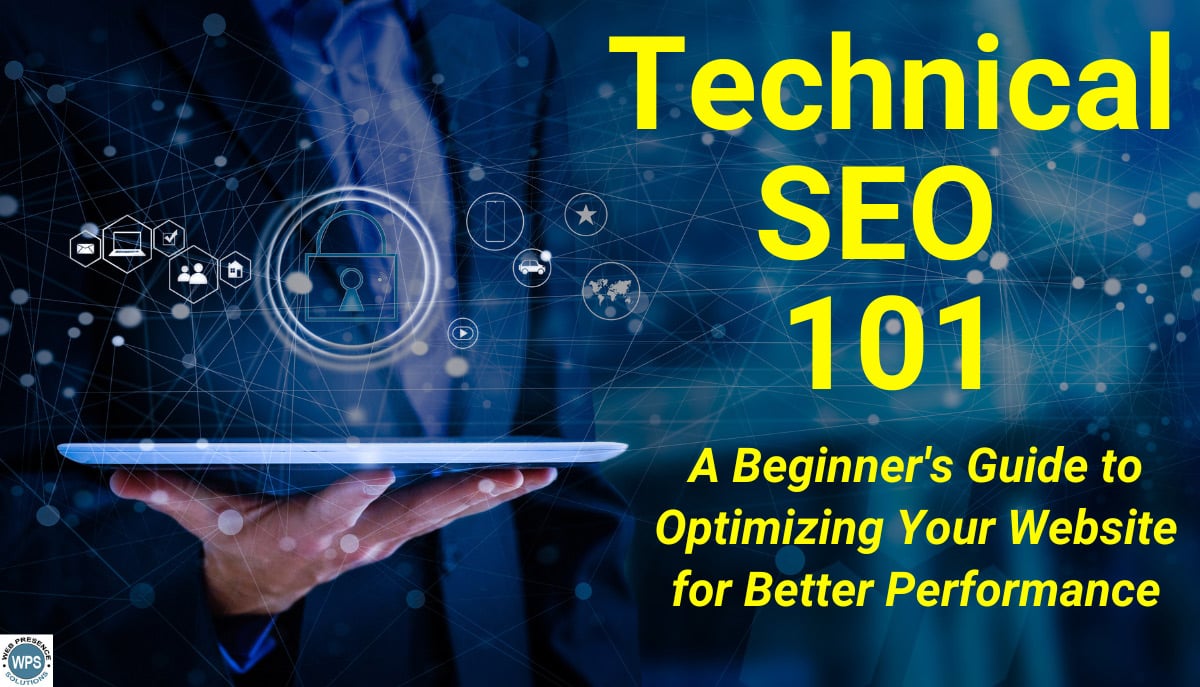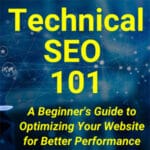Technical SEO can seem intimidating and complex, but it doesn’t have to be.
In this technical SEO guide we’ll break down the basics and show you how to optimize your website for better performance and search engine rankings.

Introduction to Technical SEO 101
Technical SEO occupies an important and valuable position in the success of your business website. It impacts your SEO strategy as well as your overall marketing efforts. In our Technical SEO guide we’ll explore a number of the key search engine optimization areas that will help you optimize your website.
This guide is written to help you navigate the world of technical SEO whether you’re a beginner or you already have some experience with SEO. The goal is to provide you with a better understanding of search engine optimization and a firmer grasp of clear steps you can take to boost your website’s performance and visibility.
What is Technical SEO?
Technical SEO is a group of processes and tasks focused on optimizing a website’s performance to ensure that it is easily accessible and understandable by search engines and delivers the best possible user experience for website visitors.
A key element of technical SEO is optimizing a website so that search engine spiders can crawl and index the site easily and effectively. If the search engines cannot crawl and index your website pages the pages won’t be visible in the search engines.
Another key aspect of technical SEO is optimizing website performance. Optimization areas include website speed, mobile-friendliness, website structure and navigation, Schema markup, and issues like slow-loading pages, broken links, large image size, and duplicate content.
Is All SEO Technical?
To many people all SEO seems technical. That isn’t actually the case. There are different aspects of SEO and they require different tactics, solutions, and tools to deliver optimal results.
While on-page SEO and off-page SEO are both important, technical SEO emphasizes areas that are less content focused and concentrates on making your website more friendly to both search engines and website visitors. When done effectively it will lead to higher rankings, increased organic traffic, and a better user experience for your website visitors.
Why Is Technical SEO Important?
Technical SEO is important because it directly impacts the performance of your website for both visitors and search engines. When a website delivers a solid user experience for visitors they are likely to visit more pages on your website and more likely to return in the future.
A technically optimized website helps search engines crawl your website and index all of your pages more efficiently. It also helps them understand your content more effectively so they are more likely to rank your pages higher and send more visitors to your website.
Some of the key benefits of implementing ongoing technical search engine optimization and for your website include:
1. Improved Search Rankings
Technical SEO directly impacts your website’s search engine rankings. By optimizing technical elements such as page-loading speed, mobile-friendliness, and URL structure, your pages will rank higher in the search engine results pages (SERPs). Search engines prioritize websites that meet their technical requirements while providing a quick and responsive user experience. If the search engine can’t crawl a page the page won’t be visible in the search engine results.
2. Indexing and Crawling Efficiency
Having search engines crawl and index your website’s content efficiently is a key aspect of technical SEO. By optimizing the technical elements and the performance of your website you make it easier for search engines to understand its structure and organization. This leads to more efficient indexing and crawling that will lead to better visibility and improved rankings.
3. More Organic Visitor Traffic from Google
When your website ranks higher on search engine results pages (SERPs), it attracts more organic visitor traffic to your site. Implementing a solid technical SEO plan will improve your website’s search engine rankings and increase your site’s visibility in the SERPs. Over time this will lead to increased organic website visitor traffic and more potential customers discovering your products or services.
4. Enhanced User Experience
As the term implies, a user experience is the positive or negative experience a visitor has when they arrive at your website. A well-optimized website delivers benefits beyond search engines and ranking. It also provides a better user experience for your website visitors.
Technical SEO elements such as fast page loading times, responsive design, and intuitive site navigation all contribute to a more positive visitor experience. When the experience is positive visitors are more likely to stay on your website, engage with your content, and convert into customers. A negative user experience can lead to a quick exit from the website, higher bounce rates, and the possibility that the visitor never returns again.
5. Mobile-Friendliness and Mobile-First Indexing
A mobile-friendly website is important for several reasons:
- The number of users accessing the internet through mobile devices continues to increase significantly.
- A website that isn’t mobile-friendly leads to a poor user experience and visitors leaving your website faster and returning less often.
- Google’s mobile-first indexing prioritizes mobile-friendly websites, emphasizing the impact of technical SEO for better mobile search rankings.
Technical SEO ensures that your website is responsive and adjusts to various screen sizes on mobile devices.
6. Better Performance of Your Marketing Programs
People sometimes forget the fact that SEO is an important part of many marketing programs for your business. A company’s website is frequently the destination for many online marketing programs, sales, and lead-generation activities.
Having a better-performing and easier-to-use website will lead to increased visitor engagement, higher conversion rates, lower bounce rates, and greater user satisfaction. It will also lead to a more positive perception of your brand.
7. Competitive Advantage
In today’s digital landscape, competition is fierce. By investing in technical SEO, you gain a competitive edge over websites that neglect these activities. A well-optimized website that loads quickly, is mobile-friendly, has clear, logical navigation, and provides a seamless user experience stands out from the crowd, often in subtle, but memorable ways. When your website works flawlessly people remember.
8. Long-Term Benefits
Technical SEO is not a one-time task. It’s not one-and-done. It requires ongoing monitoring and optimization. However, the benefits of technical SEO are long-lasting. By continuously improving your website’s technical aspects, you set a strong foundation for future SEO and marketing efforts. This also helps ensure that your website remains visible and competitive in the long run.
Related Post: What is an SEO Audit
Key Elements of Technical SEO
Now that we’ve covered the importance of technical SEO let’s explore some of the key elements that you need to consider when optimizing your website. Our Technical SEO Guide looks at nine areas for optimization.
1. Website Speed
Website speed is a key factor for delivering a positive user experience and for ranking well in search engines. Website speed can also be referred to as page-loading speed, or the speed at which a single page loads.
A slow-loading website leads to frustrated users, a high visitor bounce rate, and a low visitor engagement rate (fewer pages viewed per visit). Google prioritizes fast-loading websites and pages and considers page speed as a ranking factor for the SERPs. To improve your website’s speed, consider the following optimizations:
- Use a reliable and fast hosting provider.
- Compress and optimize all images to reduce file sizes.
- Test the loading speed of your most important pages.
- Weigh the amount of text, images, and video on a page – larger pages can load slower.
- Minimize HTTP requests by combining CSS and JavaScript files.
2. Mobile-Friendliness
The use of mobile devices for accessing the internet continues to grow. This makes having a mobile-friendly website essential. Google has implemented a mobile-first indexing approach, meaning it prioritizes the mobile version of your website for indexing and ranking. It’s also important to remember that web pages frequently load slower on mobile devices than on desktops or laptops due to slower connection speeds. To ensure your website is mobile-friendly:
- Use responsive design to adapt your website’s layout to different screen sizes.
- Test your website’s mobile-friendliness using Google’s Mobile-Friendly Test.
- Optimize your content and images for mobile devices.
3. Website Structure and Navigation
A clear website structure with logical navigation helps users navigate your site easily and search engine spiders crawl and index your site efficiently. It also creates a more positive user experience for visitors in navigating your site to locate the information and resources they are looking for. The following steps will help with optimizing your site architecture:
- Create a logical hierarchy of pages with a clear navigation menu.
- Use internal linking to connect related pages and guide search engines and visitors through your website.
- Avoid orphan pages by ensuring all pages are linked to and from other pages on your site.
- Find and fix any 404 Page Not Found errors.
4. URL Structure
Having a clean and descriptive URL structure for all of your website pages helps search engines understand your website’s content. It can also improve the user experience for visitors and make it easier for visitors to bookmark pages for future visits. Here are some best practices and suggestions for optimizing your URL structure:
- Use short, descriptive URLs that include relevant keywords.
- Avoid using complicated or irrelevant characters in your URLs.
- Do not use spaces or underlines in URLs.
5. Duplicate Content
Duplicate content or the same text content on multiple pages can harm your website’s search engine rankings and confuse search engines. It can also confuse website visitors. Here are some strategies to mitigate duplicate content:
- Regularly monitor your website for duplicate content.
- Consolidate similar content into one page to avoid duplication.
- Identify and address duplicate content issues as soon as possible.
- Implement canonical tags to avoid duplicate content issues.
6. Structured Data and Schema Markup
Schema markup and structured data help search engines understand your website content more effectively. By adding structured data to the pages on your website you can enhance search results with elements like site link navigational links, rich snippets, knowledge panels, review information, and star ratings showing up below or to the side of your listing in the SERPs.
Implementing schema markup can improve both your site’s visibility in the search engine results pages (SERPs) and the click-through rates from your listings to your website.
7. XML Sitemaps
XML sitemaps provide a structured map of your website’s pages and content to search engines. This is generally created in a file format of “sitemap.xml.” By submitting an XML sitemap, you improve the chances that all the vital pages of your website are effectively crawled and indexed.
To keep search engines informed about your website’s structure, it is recommended to regularly update and validate your XML sitemap as your site changes. This proactive approach ensures optimal search engine crawling and visibility of your website in search engine results.
8. HTTPS and Site Security
HTTPS is a secure version of an internet communication protocol. This has become the standard for all websites and a more enhancement from the earlier HTTP protocol. It helps protect data integrity and confidentiality between users and websites. Also important to note that Google uses HTTPS as a quality factor when evaluating websites and web pages.
Website pages loaded using HTTPS will display a “lock” icon in the address bar, indicating that the site is secure. It is important to use HTTPS, not the older, unsecured HTTP (no “S”) protocol for all your website URLs.
9. Broken Links and Orphan Pages
Broken links lead to non-existent pages. People who click on a broken link commonly receive a”404, Page Not Found” error. Orphan pages are pages that are not linked to from other pages on your site, may or may not be in your sitemap, and frequently have little value for website visitors. Both can negatively impact your site’s SEO and user experience. It is recommended to regularly check for and fix these issues.
How to Improve Your Website’s Technical SEO
Now that we have covered the key elements of technical SEO in our guide, let’s explore a few initial actionable steps to improve your website’s technical optimization. Here are three important starting points for enhancing your website performance and growing your business visibility.
1. Conduct a Technical SEO Audit
The best place to begin improving your website’s technical SEO is with a comprehensive technical SEO audit of your site. This type of audit will analyze aspects of your website such as page loading speed, mobile-friendliness, image sizes, site structure and navigation, broken links, duplicate content, schema markup, and more.
Having a clear list of current issues or areas to improve will help you set priorities based on their impact on your website’s performance.
2. Optimize Website Speed
This step impacts multiple areas. Improved website speed leads to faster page loading times, better mobile performance, and a better user experience for visitors to your website among other benefits.
Be sure to test all your important pages for loading time and performance. Fix the pages that don’t perform well.
3. Ensure Mobile-Friendliness
As noted earlier the number of users accessing websites via mobile devices continues to grow as does the importance of your website performance on mobile devices. Making sure that your website displays effectively and provides a positive user experience for mobile visitors is crucial.
Be sure to test all your important pages for mobile friendliness and performance on mobile phones and tablets.
Conclusion – Technical SEO Guide
Technical SEO is an essential component of an SEO strategy and an overall marketing strategy.
A solid technical SEO foundation will help deliver better visibility and rankings in Google and other search engines and an enhanced user experience for website visitors.
From optimizing site speed and mobile friendliness to eliminating broken links and implementing structured data, each aspect of technical SEO contributes to your website’s overall performance.
When optimizing your site and implementing SEO remember that it take time for the positive impact of your efforts to manifest themselves. Be patient, the benefits are well worth the investment.
Handpicked Related Posts from Our Blog (click on the icon)



